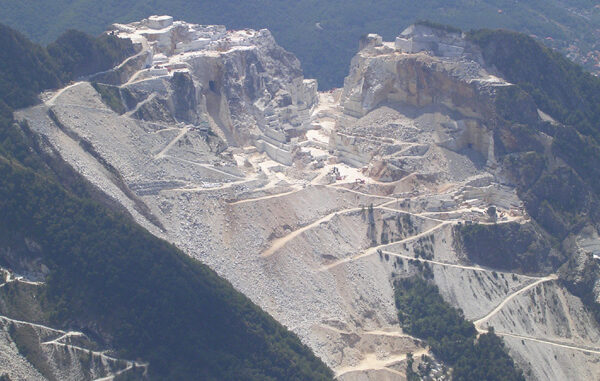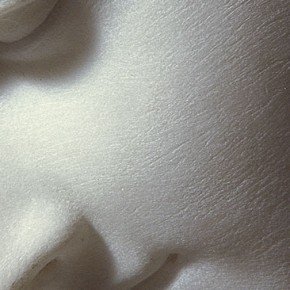
“Of course, I’ve never seen stone that can compare with the marble clean” once said Cellini.
Marble has always been the quintessential material of the sculpture. It has a symbolic meaning associated with its use in antiquity. The supremacy of white marble continued into the nineteenth century, as white is associated with purity, and the Theory of Light, where the sum of all colors results in white. In fact, defending the use of white marble went far beyond aesthetics, and was regarded as close to antiquity, and therefore perfection.
Marble is calcium carbonate in more than 75% of compact texture and average degree of hardness. There is a danger of cracking if there are any hair fractures (internal failures). Thanks to ferric oxide or copper, it may have a natural patina. It is an expensive material, due to the difficulty of extraction and transportation. For Cellini, the best marbles were the Greek, but there are numerous quarries of white marble and colored.
The quarries of Tassos (north Aegean island) and Mount Penteli (near Athens) are in Greece. These sources were highly valued for their golden hue (due to iron and mica in its composition).
In Turkey, the quarry of Proponesos provides white marble with blue, black and grey streaks.
In Italy are the famous quarries of Carrara (Apuan Alps in Tuscany), and these Roman quarries have allowed Fossacava to find countless antiquities.
Colored marbles come from different places: the black of Belgium, Greece and France; red and yellow from North Africa, and the marbling effects from Portugal, etc.
The sculptor’s work really begins with the choice of the block. Michelangelo spent long periods of time in Carrara making his selections. Before he left, he gave extensive details of how the stone had to be treated.
The process of sculpture frames the struggle of man with matter, where the mission of the sculptor is to create a human figure out of pure nature (in this case, the marble).
We can summarize the creative process of sculpture into four phases:
– Previous drawings.
– Preparatory sketch.
– Model preparation.
– Execution – Sculpture.
In the case of marble, the execution may be by direct carving or using the point system.
The tools for sculpture are divided into four: percussion, percussion cutting, drilling tools, with additional tools and abrasives for smoothing and polishing.
Tools Percussion: mallets used to strike or hit the cutting tools. They are used for the initial roughing, hitting perpendicular stone, and starting the shaping of the small portions. For example, the hammer or grinding tip is tapered from one end.
Cutters Percussion: iron or mild steel intended to be hit by a sledgehammer. The most popular of these are the chisel (straight-edged cutting instrument) and gradina (which allows for trimming close to the final form, invented by Michelangelo).
Tools for drilling: the so-called drill, used for great detail and subtlety.
Tools and natural abrasives for smoothing and polishing: the files have a grooved surface, and there are many different types for different detailed work. The abrasives used are usually pumice stone or emery powder.
One of the best sculptors was Canova, who excelled at polishing his sculptures, using sandpaper, pumice and water. Polishing could occupy months. ‘Encaustic’ is a process is attributed to Canova, and is the application of distilled wax, resulting in a transparency effect on the marble of two centimeters, which reflects the light at different depths.
Canova also spoke of burning marble on more than one occasion, and sometimes the application of certain products on the marble enhances the emotions that the sculpture conveys. For Paolina Borghese, Canova spread on a layer of wax which gave a light pink tint to the marble.
Cupid and Psychein marble is completely homogeneous and flawless. The light seems to pass through the wings. Canova’s biographer said in 1825 that the effect on the marble was the product of a spell. Canova replied with “I polished surfaces, Bernini and others did not, thus creating great contrasts and sensuality”.
Of all marbles, Carrara, from Tuscany, Italy, the best and most famous. Each year, two million tons of pure calcium carbonate grain is exported from Carrara (remember that marble is calcium carbonate in more than 75% dense). It is also exported in minimal or micronized diameters for use in industrial paper production, chemicals, pharmaceuticals, etc. There are three extraction sites: the Bacino di Torano, the Bacino di Bacino Fantiscritti and Colonnata, with their respective quarries.
The Bacino di Torano is composed of 31 active quarries, and produces thirty thousand tons of marble a month. The rarity of this marble has become very famous. The Polvaccio quarry, where Michelangelo is said to have personally quarried stone, is here. Also from here are the marbles that decorate the Royal Palace of Madrid.
The Bacino di Fantiscritti has 30 active quarries and produces thirty thousand tons of marble each month. In the heart of the deposits of Carrara, Fantiscritti has ordinary white marble, and variations including grey, ivory, with green threads, etc.
In the quarry of Carbonera, a huge monolith of 300 tons, at 18 meters long and 2.35 meters wide, was extracted in 1929, and was carved into an obelisk, which is now in Rome.
The Bacino di Colonnata comprises 29 active quarries and produces forty thousand tons of marble a month.
The complex Gioia quarries are the largest in the entire field of Carrara. Here the ordinary whites are removed, leaving the whites marbled with colour, the white brouille of the Bardiglio with their blue hues, and so on.
Along with Canova and Bernini, the great master of marble, Michelangelo, was in no doubt that Carrara was the best. For him, the idea and purpose in removing the marble to make the sculpture is superfluous:
Non ha l’ottimo artista alcun concetto
ch’un marmo solo in se non circoscriva
col suo soverchio, et solo à quello arriva
la mna, che ubbidisce all’inteletto.[1]
While the Romans used Carrara marble extensively, it was from Renaissance when the Carrara marble acquired the importance it has today. In his De statua treatise, Alberti said that the sculptor should get half of the marble for his work from Paros (Greece) and the other half from Carrara. Using this marble was also a way of relating to the ancient world.
An important task in terms of propaganda from these quarries was for the Tuscan prince of Massa Carrara and Duke Alberico Cybo-Malaspina to call and invite famous artists to the region. This stimulated the growth of a local tradition and an international high profile with respect to work in marble.
By 1550 the quarries were already very famous, and the beaches were full of ships that carried marble. Some facts: in 1557, 36 boats took marble to Genoa, increasing to 39 in 1581, and 46 in 1605.
Throughout the seventeenth century, Carrara marble was shipped to many places for sculptors and architects: Rome, Florence, Naples and Venice became regular importers of this stone.
All of this led to the development of local artists such as Francesco Baratta, who helped in the work of St. Peter’s Square and the Rio de la Plata in the Fountain of the Four Rivers in Piazza Navona. There was also Giuliano Finelli, who founded a Neapolitan workshop in Naccherino, and, in 1622, moved to Rome, where he collaborated with Bernini in his Apollo and Daphne and the Baldacchino of St. Peter. Returning to Naples, Finelli made, among others, works for the Duomo and a series of sculptures for Philip IV.
Bibliography
AAVV, Manual de técnicas artísticas,Madrid, Historia 16, 1997.
Buonarroti, M. A., Obras escogidas,Madrid, M. E. Editores, 1997.
Wagner, M., “Reinheit und Gefährdung. Wei?er Marmor aïs ästhethische und ethnische Norm um 1800”(Pureza y peligro. El mármol blanco como norma estética y étnica hacia 1800), conferencia en ¿Una historia material del arte? Las técnicas artisticas como procesos culturales, Madrid, Museo Thyssen-Bornemisza, marzo-abril 2009.
Wittkower, R., La escultura: procesos y principios, Madrid, Alianza, 2002.
[1] Buonarroti, M. A., Obras escogidas, Madrid, M. E. Editores, 1997, p. 49.



Leave a Reply